Day 156: Probability Boot Camp
Every year it seems my students need additional practice with probability. I was Twitter-lurking again this week and came across Bob Lochel‘s response to a post asking about how people are prepping their kids. Just as David Griswold shared, I had searched for this gem and never did find it. Thanks Bob for sharing!
The questions in this review are thoughtfully put together, mixing in different key concepts and processes for probability. As a class, we talked through the first question together. Then I had the students work on the second question, and did a Navigator quickpoll with the intent to talk about the different answers. I was pleasantly surprised with how many answered correctly (although they didn’t follow directions for sig-figs). But we also were able to analyze the errors: gave the z-score, didn’t subtract from 1…and we followed that up with what might have happened).
As we continued, their success rate improved as is evidenced in this quickpoll results.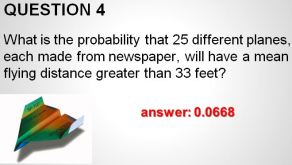
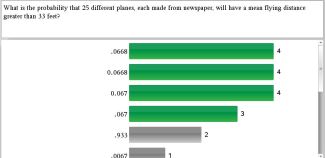
I particularly like these two questions as they ask students to put together multiple ideas and solve the problem using a multi-step process…so AP-like!
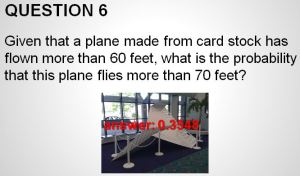
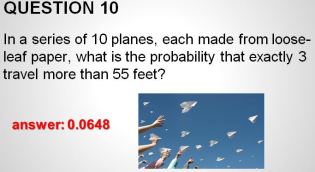
I really do like to use the quickpoll function of the Navigator to encourage mistake-analysis and engagement. What do you do to help students analyze mistakes?
Posted on May 8, 2015, in Uncategorized and tagged AP Prep, AP Statistics, probability. Bookmark the permalink. 6 Comments.
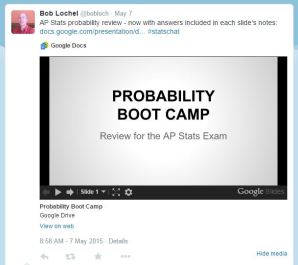
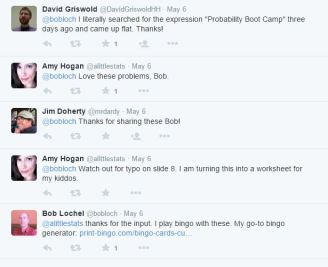
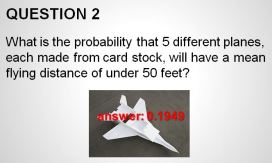


What a great activity. This will be great for my classes next week. I am drawing a blank on the first question though. I can get the rest of them, but for some reason that one is not working out for me. Can you explain how you solve that problem?
LikeLiked by 1 person
On my gosh…you are my FIRST official comment after all of these months of blogging! This a blogging red-letter day for me!
Okay, so to answer you question, since the problem is about 5 planes and not one, AND we’re trying to find the probability that the “mean” flying distance is under 50 feet, this is a sampling distribution situation. Thus, P(x-bar < 50) = P(z < -0.8600) = 0.1949, where z = (50-55)/(13/sqrt(5)). Hope this is clear enough. If you'd like a copy of the answer key worked out, just send me an email. Here is the link to the full document so you can see all ten problems. I’m really sorry I don’t know who the original author was, but perhaps Bob Lochel. Let me know how the activity works for your students. Mine said they felt much more confident after doing these problems.
LikeLike
Wow you have a lot of great stuff on your blog, I’m surprised I’m the first to comment. The problem I am having trouble with is the one that asks for the prob. that a loose-leaf plane flies farther than a card stock plane.
LikeLike
Oh gosh,sorry, I thought you meant problem #2…long Friday afternoon! We did this one together as a class because I thought it uses random variables along with normal calculations, and it would get my students thinking about probabilities that combine multiple things. Since we are finding the P(LL>CS), which is also P(LL-CS>0), the key is to define the distribution for the difference LL-CS. Since LL and CS are random normal variables that are independent, the random variable rules apply. The mean of LL-CS is mean(LL)-mean(CS) = 40-55 = -15. To find the standard deviation of LL-CS, we need the variances of LL and CS, which are Var(LL)=12^2 and Var(CS)=13^2. Variances always add (even when working with the differences of two random variables as long as the two variables are independent – great time to review this requirement for SD before the exam), so Var(LL-CS) = 144+169 = 313, which results in SD(LL-CS)=sqrt(313) or approx 17.69…. Now P(LL-CS>0)=P(z>0.847…)=0.1983.
Thanks so much for your sweet comment; I’m glowing all over. The blogging journey has been an exercise in self-reflection and a documentary of things I’ve done during the year. I’ve noticed that since I started the blog, I want interesting things to post, so it has moved me (forced, maybe?!) to try new things as well as look for activities that really impact my students’ understanding while also getting them engaged in thinking. I’m reading more blogs, lurking in Twitter and Pinterest, and actually putting into practice things I think sound promising.
LikeLike
Thanks so much for the explanation. It makes perfect sense now 🙂
LikeLike
Pingback: Stats Crescendo | soar180year2